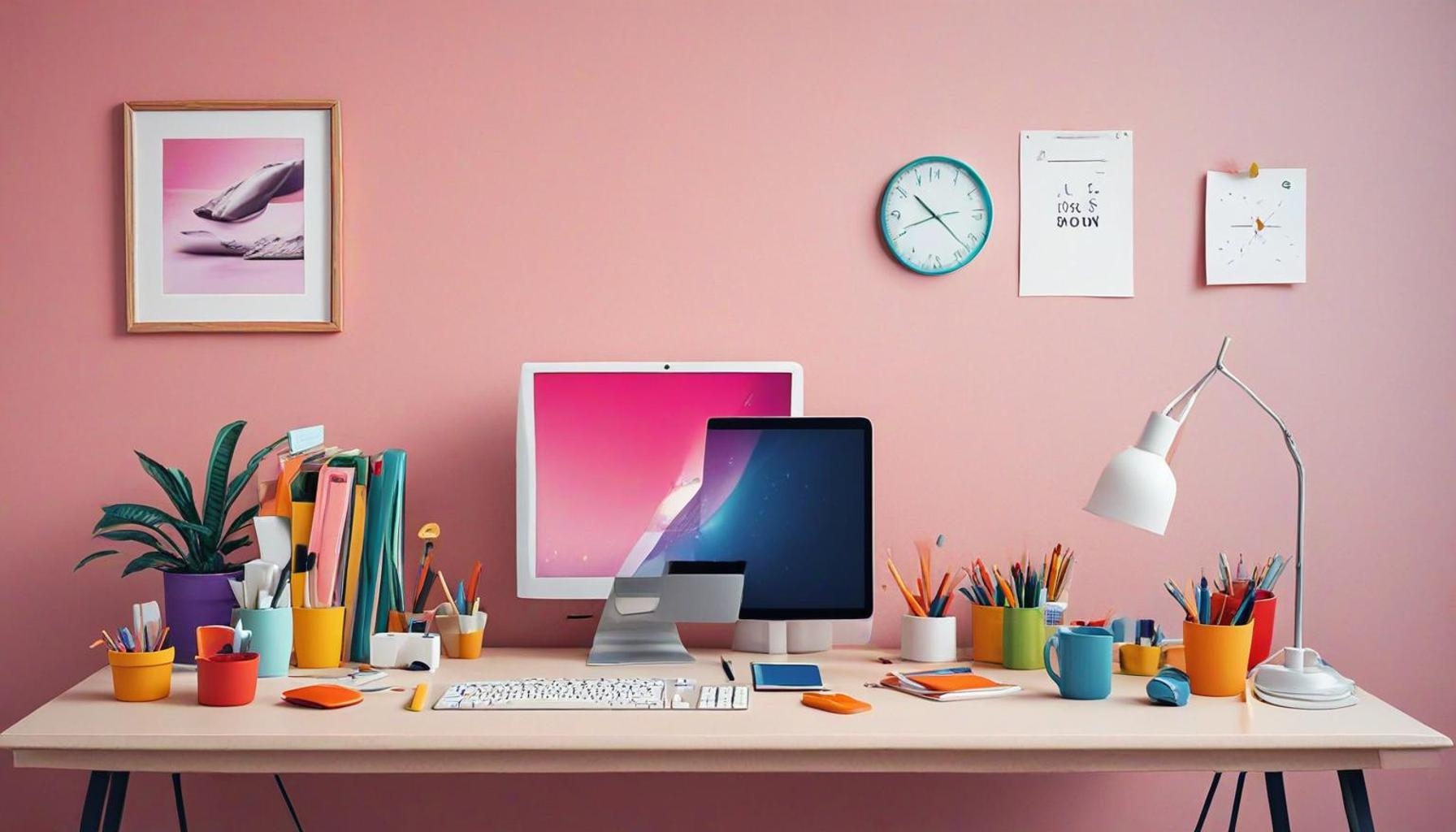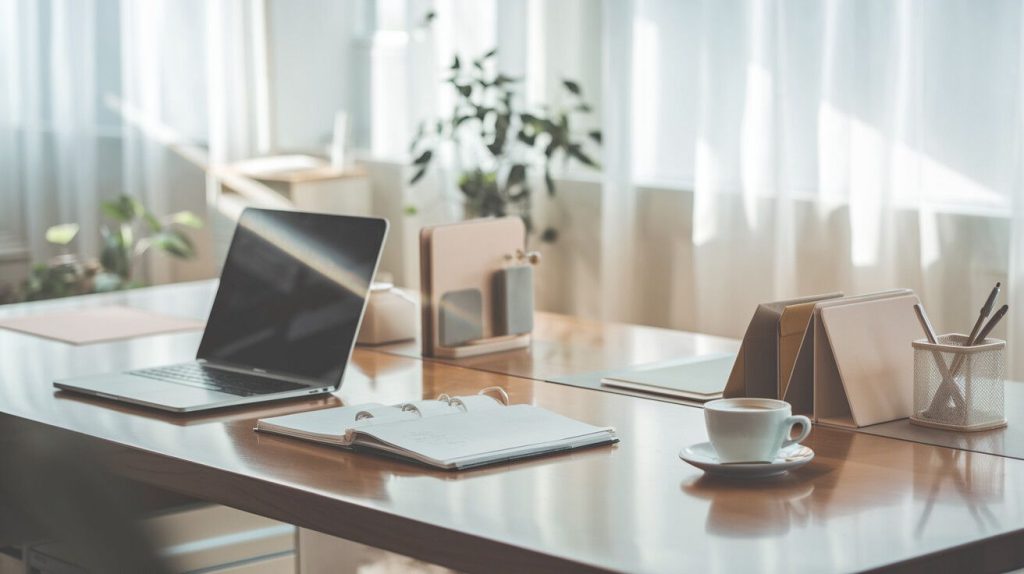How Minimalism Can Transform Your Workspace: Tips for a Productive Environment

Understanding the Impact of Minimalism on Workspaces
In today’s fast-paced world, a cluttered workspace can hinder productivity and creativity. Many professionals are turning to minimalism as a solution to enhance their work environment. By adopting a minimalist approach, you can create a space that fosters focus and efficiency. Minimalism emphasizes simplicity, functionality, and intentionality, which can make a significant difference in how one works and creates.
The initial step in transforming your workspace begins with understanding the benefits of a minimalist approach. A tidy environment can significantly reduce distractions. For instance, studies indicate that individuals who work in clean and organized spaces report higher levels of concentration and lower stress levels. Moreover, when fewer items are present, it’s easier to maintain focus on crucial tasks, thereby enhancing productivity.
- Reduced distractions: A clean and organized workspace helps maintain concentration by minimizing visual and auditory clutter, which can divert attention.
- Improved organization: With fewer items, managing tasks and meeting deadlines can be more straightforward. An organized workspace allows for quicker access to materials and information, streamlining processes.
- Enhanced creativity: A serene environment encourages innovative thinking and problem-solving. When your mind isn’t occupied with chaos, it has the freedom to explore new ideas and concepts.
Practical Steps to Embrace Minimalism
Consider the various aspects of your workspace that can be refined. Simplifying your workstation doesn’t have to involve extreme measures. For example:
- Desk items: Limit your desk to essentials like your computer and a notepad. Avoid unnecessary gadgets or memorabilia that can create distractions.
- Color schemes: Opt for neutral tones, such as whites, grays, or soft pastels, to reduce visual clutter and promote calmness. These colors can help create a more focused atmosphere.
- Digital organization: Take a minimalist approach to your digital workspace as well. Keep your desktop clutter-free by organizing files into labeled folders, ensuring quick and efficient access to important documents.
Embracing minimalism also allows you to cultivate a mindset focused on quality over quantity. This philosophy encourages individuals to pursue meaningful projects and eliminate the superfluous. As you explore the tips in this article, you’ll uncover practical ways to minimize distractions and maximize productivity. By implementing these strategies, you’ll not only transform your physical workspace but also enhance your overall work habits, leading to a more satisfying and effective professional life.
DISCOVER MORE: Click here for design tips to maximize your space

Practical Steps to Embrace Minimalism
Transforming your workspace into a minimalist haven does not require a complete overhaul. Instead, it can be achieved through a series of intentional and practical steps that cater to both aesthetic appeal and functionality. Here are several ways to effectively embrace minimalism in your work environment:
- Declutter Regularly: Set aside a few minutes each week to evaluate the items on your desk. Keep only what you need and remove everything else. This consistent practice can help prevent clutter from accumulating and allows you to start each week afresh.
- Create a Designated Home for Each Item: Organize your supplies and tools so that everything within arm’s reach has a specific place. Having a designated space for each item not only enhances organization but also fosters a calm mind, making it easier to locate what you need.
- Limit Personal Items: While personal touches can add warmth to your workspace, too many can be distracting. Choose a few meaningful items that inspire you and remove the rest to maintain a more streamlined appearance.
Incorporating technology mindfully is an essential aspect of a minimalist workspace. Digital distractions can quickly derail productivity, so paying attention to your digital space is just as critical as your physical one. Start by decluttering your computer desktop and email inbox. Here are some additional tips:
- Update Your Digital File System: Organize files into clearly labeled folders, eliminating expired or irrelevant documents. This will make it easier to find important files when needed and can prevent digital overwhelm.
- Utilize Task Management Tools: Leverage apps such as Trello or Asana to keep track of your tasks and deadlines. By moving away from physical to-do lists or sticky notes, you can keep your workspace cleaner and reduce paper clutter.
- Limit Notifications: Turn off non-essential notifications on your devices. Constant alerts can interrupt your flow, making it difficult to remain focused on the task at hand.
Understanding that minimalism goes beyond physical items is crucial. It also influences how you approach your work. By prioritizing tasks based on importance and urgency, you will be more inclined to engage in quality work rather than spreading yourself thin across multiple minor responsibilities. This philosophy of quality over quantity encourages a more profound commitment to the projects you take on, fostering a more satisfying work experience.
As you delve into the journey of minimalism, remember that it is not about deprivation but rather about uncovering the essence of what truly matters in your work life. Implementing these strategies will not only clear your physical and digital space but also enhance your productivity and creativity, ultimately leading to a more fulfilling and efficient professional life.
How Minimalism Can Enhance Focus and Creativity
Embracing minimalism in your workspace offers a plethora of benefits that extend beyond mere aesthetics. One of the core advantages of a minimalist workspace is the significant boost in focus. By eliminating clutter and distractions, individuals create an environment conducive to deep, uninterrupted work. This has profound implications for productivity levels, as a clear desk often leads to a clear mind. Research shows that individuals working in less chaotic surroundings tend to complete tasks more efficiently, as their attention is not constantly diverted by superfluous items or noise.In addition to enhancing focus, minimalism also fosters creativity. When the physical space is decluttered, mental clutter naturally follows suit. A minimalist workspace encourages innovative thinking by allowing your mind the freedom to explore new ideas without being shackled by excess distractions. With fewer visual stimulants, brain resources can be redirected towards problem-solving and creative exploration. Moreover, adopting a minimalist approach in your workspace can enhance overall well-being. A clean and ordered environment reduces stress and anxiety levels, making it easier to tackle complex tasks. Studies indicate that individuals in minimalistic spaces report lower levels of frustration and find it simpler to maintain a consistent workflow. In essence, the transformation that minimalism brings to your workspace is profound. It cultivates an atmosphere that not only promotes productivity but also nurtures creativity and mental clarity. As you rethink the design of your workspace, bear in mind these principles of minimalism and how they can be the key to unlocking your potential. The shift toward a minimalist workspace is not just about aesthetics; it’s a strategic move towards enhancing overall performance and satisfaction in your work life.
| Advantage | Description |
|---|---|
| Improved Focus | A decluttered workspace minimizes distractions and enhances concentration. |
| Enhanced Creativity | Less clutter encourages innovative thinking and exploration of new ideas. |
| Reduced Stress | An ordered environment can lower anxiety and promote a more enjoyable work experience. |
With these compelling advantages in mind, it’s time to consider how minimalism can transform your own workspace. Take the plunge into a simpler, more focused environment, and watch as your productivity and creativity flourish.
DISCOVER MORE: Click here to delve deeper
Rethink Your Workspace Layout
A minimalist workspace is not only about having fewer items but also about strategically arranging what remains. The layout of your workspace can dramatically affect your productivity and mental clarity. Here are some considerations to reshape your environment:
- Adopt an Open Layout: If possible, opt for an open layout that promotes movement and creates a sense of space. Consider positioning your desk in a way that allows natural light to flood in. Studies have shown that natural light can enhance mood and productivity, making it a crucial component in a minimalist design.
- Use Multi-Functional Furniture: Invest in multi-purpose furniture that minimizes clutter while maximizing functionality. For example, consider a desk with built-in storage to eliminate the need for multiple filing cabinets. Furthermore, chairs that double as storage units can help streamline the appearance of your workspace.
- Incorporate Plants: Integrating greenery into your workspace can enhance air quality and boost creativity. Selecting a few low-maintenance plants, such as succulents or pothos, can bring a lively touch to a minimalist environment without overwhelming it.
Establish a Routine of Mindfulness
Minimalism extends beyond the physical spaces and into your daily habits. Cultivating a mindset of mindfulness can drastically improve your productivity and well-being:
- Schedule Focused Work Sessions: Allocate specific times each day for uninterrupted work. The Pomodoro Technique, which involves 25 minutes of focused work followed by a 5-minute break, can help maintain concentration while preventing burnout. This practice ensures that you engage fully with fewer tasks at hand.
- Engage in Digital Detox: Consider scheduling regular digital detox periods. This could mean avoiding social media or reducing screen time during specific hours. By consciously stepping back from digital distractions, you can enhance your focus and re-engage with your work in a more constructive manner.
- Reflection Time: Set aside moments at the end of each workday to assess your accomplishments and plan for the next day. Reflecting on what you achieved can foster gratitude and motivate you to adopt a minimalist approach to your future tasks.
Educate Yourself on Minimalist Principles
To truly understand the philosophy of minimalism, you may find it beneficial to delve into literature and resources that detail its principles. Books like “Essentialism: The Disciplined Pursuit of Less” by Greg McKeown or “The More of Less” by Joshua Becker explore minimalism not just as a lifestyle but as a pathway to enhanced effectiveness and satisfaction:
- Follow Minimalist Content Creators: Platforms like YouTube and Instagram host numerous influencers dedicated to minimalism. Engaging with their content can provide practical insights and inspire you to embrace a streamlined approach in your own workspace.
- Join Minimalism Communities: Online forums and social media groups offer a space for sharing experiences, tips, and strategies. These communities can provide motivation and support as you navigate your journey towards a more minimalist workspace.
Ultimately, adapting a minimalist mindset involves seeing beyond the aesthetics to embrace the core value of efficiency and simplicity. By reassessing your workspace layout, cultivating mindful habits, and educating yourself about minimalist practices, you can foster an environment that encourages productivity, creativity, and peace. As you implement these strategies, remember that minimalism is a personal journey tailored to your needs and preferences, offering the flexibility to define it in a way that works for you.
DIVE DEEPER: Click here to discover how mindfulness can enhance your productivity
Conclusion: Embrace the Minimalist Advantage
In a world increasingly driven by distractions and clutter, minimalism offers a transformative approach to enhancing your workspace and productivity. By consciously simplifying your environment, you not only remove the physical items that weigh you down but also declutter your mind. The tips outlined—from rethinking your workspace layout to establishing routines of mindfulness—empower you to make intentional choices that support focus and innovation.
Consider the impact of a clean, organized space on your mental well-being and creativity. Minimalism encourages you to prioritize what truly matters, allowing you to allocate your energy to tasks that align with your goals. Engaging in a digital detox and counting on low-maintenance plants can further invigorate your workspace, elevating both air quality and inspiration.
As you explore your personal minimalist journey, keep in mind that there is no one-size-fits-all approach. Utilize resources and communities that resonate with you, seek inspiration from minimalist content creators, and adapt the principles you learn to fit your unique needs. This exploration can lead to not just a more productive environment, but a profound shift in your overall lifestyle.
In conclusion, embracing minimalism in your workspace is more than an aesthetic choice; it is a pathway to a more efficient and fulfilling professional experience. As you strip away the excess, you may find that the beauty of simplicity opens doors to enhanced creativity, improved focus, and a renewed passion for your work.


